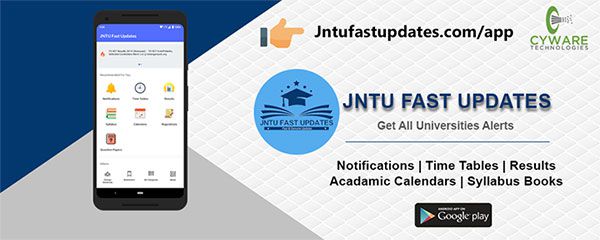JNTUK R20 1-2 Applied Physics Material PDF Download
Students those who are studying JNTUK R20 ECE, EEE Branches, Can Download Unit wise R20 1-2 Applied Physics Material/Notes PDFs below.

JNTUK R20 1-2 Applied Physics Material PDF Download
UNIT-1
Wave Optics
Interference: Principle of superposition –Interference of light – Interference in thin films (Reflection Geometry) & applications -Colors in thin films- Newton’s Rings- Determination of wavelength and refractive index.
Diffraction: Introduction – Fresnel and Fraunhofer diffraction – Fraunhofer diffraction due to single slit, double slit – N-slits(Qualitative) – Grating – Dispersive power and resolving power of Grating(Qualitative).
Polarization: Introduction-Types of polarization – Polarization by reflection, refraction and Double refraction – Nicol’s Prism -Half wave and Quarter wave plates
Unit Outcomes: The students will be able to
- Explain the need of coherent sources and the conditions for sustained interference (L2)
- Identify engineering applications of interference (L3)
- Analyze the differences between interference and diffraction with applications (L4)
- Illustrate the concept of polarization of light and its applications (L2)
- Classify ordinary polarized light and extraordinary polarized light (L2)
Download UNIT-1 Material PDF | Reference-2 | Ref-3
Unit-2
Lasers and Fiber optics
Lasers: Introduction – Characteristics of laser – Spontaneous and Stimulated emissions of radiation – Einstein’s coefficients – Population inversion –Lasing action- Pumping mechanisms – Ruby laser – He-Ne laser – Applications of lasers.
Fiber optics: Introduction –Principle of optical fiber- Acceptance Angle-Numerical ApertureClassification of optical fibers based on refractive index profile and modes –Propagation of electromagnetic wave through optical fibers – Applications.
Unit Outcomes: The students will be able to
- Understand the basic concepts of LASER light Sources (L2)
- Apply the concepts to learn the types of lasers (L3)
- Identifies the Engineering applications of lasers (L2)
- Explain the working principle of optical fibers (L2)
- Classify optical fibers based on refractive index profile and mode of propagation (L2)
- Identify the applications of optical fibers in various fields (L2)
Download UNIT-2 Material PDF | Reference-2
UNIT-3:
Quantum Mechanics, Free Electron Theory and Band theory
Quantum Mechanics: Dual nature of matter – Heisenberg’s Uncertainty Principle – Significance and properties of wave function – Schrodinger’s time independent and dependent wave equations– Particle in a one-dimensional infinite potential well.
Free Electron Theory: Classical free electron theory (Qualitative with discussion of merits and demerits) – Quantum free electron theory– Equation for electrical conductivity based on quantum free electron theory- Fermi-Dirac distribution- Density of states (3D) – Fermi energy.
Band theory of Solids: Bloch’s Theorem (Qualitative) – Kronig – Penney model (Qualitative)- E vs K diagram – v vs K diagram – effective mass of electron – Classification of crystalline solids–concept of hole.
Unit Outcomes: The students will be able to
- Explain the concept of dual nature of matter (L2)
- Understand the significance of wave function (L2)
- Interpret the concepts of classical and quantum free electron theories (L2)
- Explain the importance of K-P model
- Classify the materials based on band theory (L2)
- Apply the concept of effective mass of electron (L3)
Download UNIT-3 Material PDF | Reference-2 | Ref-3
Unit-4:
Dielectric and Magnetic Materials
Dielectric Materials: Introduction – Dielectric polarization – Dielectric polarizability, Susceptibility and Dielectric constant – Types of polarizations- Electronic (Quantitative), Ionic (Quantitative) and Orientation polarizations (Qualitative) – Lorentz internal fieldClausius- Mossotti equation- Piezoelectricity.
Magnetic Materials: Introduction – Magnetic dipole moment -MagnetizationMagnetic susceptibility and permeability – Origin of permanent magnetic moment – Classification of magnetic materials: Dia, para, Ferro, antiferro & Ferri magnetic materials – Domain concept for Ferromagnetism & Domain walls (Qualitative) – Hysteresis – soft and hard magnetic materials- Eddy currents- Engineering applications.
Unit Outcomes: The students will be able to
- Explain the concept of dielectric constant and polarization in dielectric materials (L2)
- Summarize various types of polarization of dielectrics (L2)
- Interpret Lorentz field and Claussius- Mosotti relation in dielectrics(L2)
- Classify the magnetic materials based on susceptibility and their temperature dependence (L2)
- Explain the applications of dielectric and magnetic materials (L2)
- Apply the concept of magnetism to magnetic data storage devices (L3)
Download UNIT-4 Material PDF | Reference-2 | Ref-3
Unit-5:
Semiconductors and Superconductors
Semiconductors: Introduction- Intrinsic semiconductors – Density of charge carriers – Electrical conductivity – Fermi level – extrinsic semiconductors – density of charge carriers – dependence of Fermi energy on carrier concentration and temperature – Drift and diffusion currents – Einstein’s equation- Hall effect – Hall coefficient –Applications of Hall effect.
Superconductors: Introduction – Properties of superconductors – Meissner effect – Type I and Type II superconductors – BCS theory (Qualitative) – Josephson effects (AC and DC) – SQUIDs – High Tc superconductors – Applications of superconductors.
Unit Outcomes: The students will be able to
- Classify the energy bands of semiconductors (L2)
- Interpret the direct and indirect band gap semiconductors (L2)
- Identify the type of semiconductor using Hall effect (L2)
- Identify applications of semiconductors in electronic devices (L2)
- Classify superconductors based on Meissner’s effect (L2)
- Explain Meissner’s effect, BCS theory & Josephson effect in superconductors (L2)
Download UNIT-5 Material PDF | Reference-2 | Ref-3
TEXT BOOKS:
- M. N. Avadhanulu, P.G.Kshirsagar & TVS Arun Murthy” A Text book ofEngineering Physics”- S.Chand Publications, 11th Edition 2019.
- Engineering Physics” by D.K.Bhattacharya and Poonam Tandon, Oxford press(2015).
- Applied Physics by P.K.Palanisamy SciTech publications.
REFERENCE BOOKS:
- Fundamentals of Physics – Halliday, Resnick and Walker, John Wiley &Sons
- Engineering Physics by M.R.Srinivasan, New Age international publishers (2009).
- Shatendra Sharma, Jyotsna Sharma, “ Engineering Physics”, Pearson Education, 2018
- Engineering Physics – Sanjay D. Jain, D. Sahasrabudhe and Girish, University Press
- Semiconductor physics and devices- Basic principle – Donald A, Neamen, Mc Graw Hill
- B.K. Pandey and S. Chaturvedi, Engineering Physics, Cengage Learning

320-x100(1).gif)

I want important questions for sem preparation
I want important question of physics for my supply exam
Where is quantum mechanics in that pdf
I want pdf